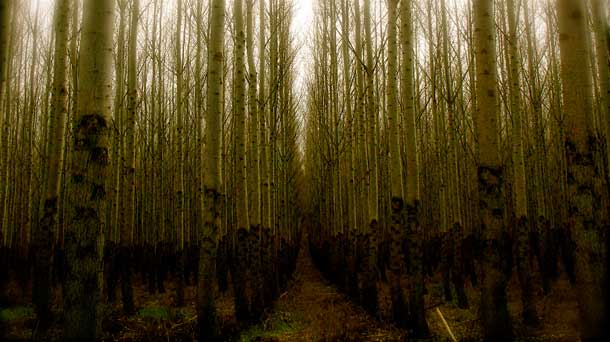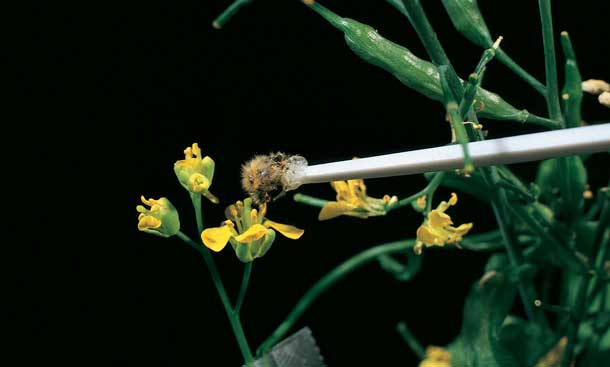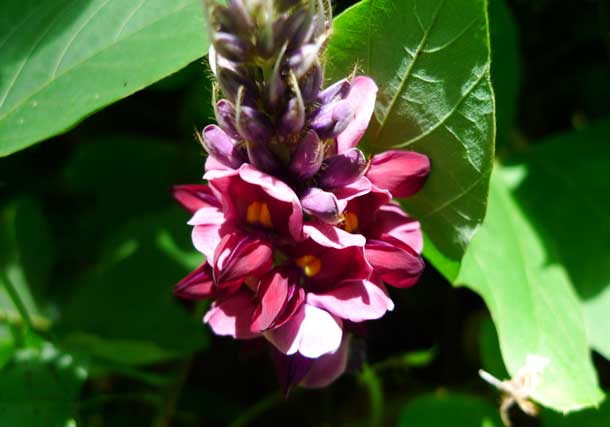From their miraculous fertility to their value for the impatient landscaper and ultraproductive farmer, plants that grow really fast have long held our fascination.
In honor of this enduring appeal, here are 10 incredibly fast growing trees and plants that shoot up like Jack’s giant beanstalk and multiply like rabbits in some of nature’s fiercest turf wars.
1. Bamboo

Bamboo (Moyan_Brenn / Flickr)
Lucky bamboo has been recognized for its sustainable productivity for millennia. The giant grass of Asian fame employs a specialized rhizomatic, spreading root structure allowing multiple shoots to emerge from the same rootstock.
The horizontal network makes it easy to triage the distribution of moisture and nutrients across a whole patch of bamboo shoots, adding an impressive three feet of height each day in certain species. The record, according to The Book of Bamboo, is four feet–a steady daily march of 0.00002 mph.
2. Hybrid Poplar

Hybrid-Poplar (Terry Bain / Flickr)
Nature produces a number of optimal growth traits that humans have been able to artificially extend via crossbreeding. In favorable conditions, for example, a young eastern cottonwood can easily grow 10 feet annually. Its fecundity makes it an attractive cultivar for crosses like the Hybrid Poplar, a high-performing agroforestry product sold since the ’70s.
As cottonless shade trees that mature in a hurry, Hybrid Poplars can be harvested in as little as five years. Such short rotations have made them a go-to resource for fiber, lumber and, increasingly, bioenergy for fuel supplies.
3. Algae

Algae (Sarah Camp / Flickr)
The simplest of plantlike organisms, algae are high-yield photosynthesizers found in most habitats. Of many thousands of species, some 300 have become notorious for periodically erupting into toxic “blooms.” Fueled by agricultural runoff, blooms are explosive growth episodes in which hyperactive algae multiply into the millions, creating a huge, slimy mass in the water column. The seething tide creates an ominous “dead zone” in its wake, as the insatiable algae quickly consume all the oxygen required to sustain marine life.
4. Duckweed

Duckweed (Wikepedia)
Wolffia microscopica, affectionately known as “duckweed,” is both the world’s smallest flowering plant and one of its fastest reproducers. On a population scale, few species can compete with the superlative reproductive skills of the freewheeling Wolffia. The protein-dense pond-dweller completes a life cycle every 30 hours. Just a bit of this plant’s fuzz can harbor millions of tiny green progeny. In theory, a single duckweed could produce enough offspring to fill a Earth-sized bucket in approximately four months.
5. Giant Sequoia

Giant-Sequoia (SpecMode / Flickr)
The Giant Sequoia’s uncommon growth rate springs not from its height but its colossal trunk, which amasses rings faster than any other tree known to science. In the 1970s, researchers calculated a storied California sequoia named the “General Sherman Tree” was in fact the fastest growing single tree specimen in the world, having expanded its trunk by three inches in the previous 40 years. For a tree exceeding thirty feet in diameter with its crown high in the clouds, that amounts to astronomical rates of woody accumulation–equivalent to a sapling sprouting from scratch into a stout 50-foot-high hardwood, year after year.
6. Wisconsin Fast Plants

Wisconsin Fast Plants (Carolina Biological Supply Company / Flickr)
A life cycle of just one month is a rare feat in the world of plants, but researchers at the University of Wisconsin have proven it can be done with the intelligent combination of naturally quick-blooming flora and selective breeding. “Wisconsin Fast Plants,” a trademarked strain of the common field mustard, accomplish germination, leaf formation, budding, flowering and seed maturation in an eye-blink. The result is a low-maintenance plant with special educational and research appeal, capable of rapid-cycling from one generation to the next every five weeks.
7. Kudzu

Kudzu (dmott9 / Flickr)
When conditions are warm and sunny, Japanese arrowroot, or “kudzu,” wastes no time. It grows a foot every day, reaching nearly 60 feet in a season. Its growth might be considered a boon were it controllable, but kudzu is a stubborn climber that expands at the expense of just about everything in its proximity. It eventually smothers neighboring flora, choking off plants’ and trees’ access to life-giving sunshine. Able to reduce entire forests to skeletons, kudzu is incredibly difficult to kill. The metastasizing vine has become a poster child for sneaky invasive plants in the U.S.
8. Empress Tree

Empress Tree (Goosefriend / Flickr)
Commonly marketed as the world’s fastest growing hardwood, the colorful Royal Empress tree, or Paulownia, draws praise and criticism alike for its stunning seasonal growth rates of between 10 and 15 feet. You’ll have to crane your neck to spy the 85-foot crown of a mature ‘Princess’ after just seven years. Not that you should actually plant this tree in your yard. While there’s no shortage of sellers promoting it as “genetically superior,” the Empress Tree is technically considered an invasive species by the USDA.
9. Cretaceous Gingko

Cretaceous Gingko (Wikepedia)
How did the herbivorous dinosaurs ever get their fill? 160 million years ago, the paleoatmosphere had much higher concentrations of oxygen and carbon dioxide. It was a warm, enriched greenhouse, the perfect incubator for plants and trees–among them early strains of Gingko biloba. In 2004, researchers subjected ginko plant seedlings to the carbon-heavy air of the distant past, and the results were telling: the ginkgos’ growth rates tripled. These findings add to our knowledge of how the steamy air breathed by T-rex once promoted hyperfertile, fast growing plants capable of satisfying beastly dinosaur appetites.
10. Genetically Modified Eucalyptus

Genetically Modified Eucalyptus (Wikepedia)
Biotech companies have been tinkering with tree genomes for decades. Today, the industry has shifted to commercial-scale production of genetically modified, or GM, versions of fast growing species like eucalyptus. “Transgenic” eucalyptus, spliced with the genes of Brassica weeds, exhibit 30% faster growth curves. A mutant eucalyptus tree can spring up to sixteen feet in a single season, reaching nearly 100 feet in just five years. GM tree biotech has been called the forestry of the future by advocates, while critics warn of genetic pollution caused by ‘zombie trees’ that make invaders like kudzu look well-mannered.